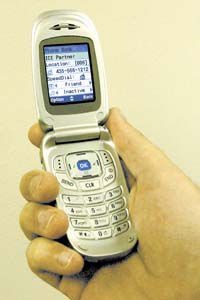| Adding an emergency contact to mobile phones may help emergency personnel know who to contact in emergency cases. |
A public safety campaign that started in the U.K. is expanding to the United States. The campaign focuses on adding an entry for emergency contact to mobile phones.
The plan developed last year when Bob Brotchie, a paramedic in Cambridge, England, found difficulty determining who to call in an emergency.
Brotchie suggested that mobile phone users could use the acronym ICE for “in case of emergency” in their contact lists on their phone. That way, emergency personnel would have a clear indicator of who to contact.
Among the campaign’s supporters is Vodafone, a United Kingdom-based mobile provider. A survey conducted by the mobile carrier suggests that more than 75 percent of people carry no details of who to contact in an emergency.
Brotchie explained that he was looking back on some of the calls he has responded to in the 13 years he has worked as a paramedic.
Brotchie indicated that, many times, he had looked through the contact list on the victim’s phone, but was often unable to determine who was the next of kin of the individual involved in an emergency situation.
The problem arises when consumers have nicknames for people in the mobile phone. Examples include mom, mother, mommy or synonyms and nickname for parents, spouses, children or others who are close to the owner of the phone.
And just because someone is included on an individual’s contact list does not mean that the victim would want the person contacted in an emergency.
“Almost everyone carries a mobile phone now, and, with ICE, we’d know immediately who to contact and what number to ring. The person may even know of their medical history,” said Brotchie.
Choosing who a contact is can be a tricky task for consumers.
The program’s website at http://www.ice.com/ gives pointers on selecting contacts.
The program recommends that Carbon County residents:
•Make sure the person whose name and number they are giving has agreed to be an ICE partner.
•Make sure the ICE partner has a list of the people who should be contacted on the victims’s behalf, including the individuals place of work.
•Make sure an ICE person’s number is one that’s easy to contact.
For example a home number could be useless in an emergency if the person works full time.
•Make sure the ICE partner knows about any medical conditions that could affect emergency treatment.
Examples include allergies or current medication.
•For individuals younger than 18 years of age, ICE partners are a parent or guardian authorized to make decisiona on the minors’ behalf.
Examples are when youth need a life or death operation.
•If a preferred contact is deaf, people should prefix the number with ICETEXT.
In addition, the promoters of the safety campaign have had to deal with some setbacks in the campaign.
An email which has been circulating the Internet, calls the campaign a hoax.
The email claims that ICE is a type of mobile phone virus which accesses the address book, uses air time and drains a pay-as-you-go phone of its credits.
Matt Ware, spokesman for the East Anglian Ambulance Service, recently asked people to ignore the hoax email.
“I have been inundated with emails and phone calls from people worried that, having put ICE into their mobiles, they are now going to be charged for the privilege,” said Ware. “We would like to assure people that that’s not the case. Whoever began this second email chain is obviously a malicious person with way too much time on their hands. By adopting the ICE advice, your mobile will now also help the rescue services quickly contact a friend or relative – which could be vital in a life or death situation,” added the ambulance service spokesperson.
McAfee, a leading anti-virus company, confirmed the hoax, urging recipients of the email in Carbon County to delete the message and not pass it on.Brotchie hoped mobile phone companies will build the ICE contact into future models.
“It’s not a difficult thing to do. As many people say they carry mobile phones in case of an emergency, it seems natural this information should be kept there,” noted Brotchie.
However, as the campaign has gained publicity, some have suggested potential problems with the program.
Contacsts listed as ICE partners on a mobile phone may become obsolete. If the contact’s number is changed or disconnected, a new partner needs to be added.
In addition, the relationship between the phone users and their contacts may change.
Death, divorce, family feuds or a move to another location may require mobile phone users to change their ICE partners.
In addition, there are problems with relying on the entry in a phone’s contact list. First, the program is widely adopted in the U.K., but hasn’t caught on to the same level in the United States.
Second, if a mobile phone is not charged, doesn’t work properly, or is locked with a security code, emergency personnel may not be able to access the information.
Having the information available in another format could help in those situations. Contact information in a victim’s wallet or purse could serve the same purpose as that found in a mobile phone.
The U.S. Department of Homeland Security has made a contact sheet available as part of its family preparedness plan available on the department’s website, http://www.ready.gov/. The contact sheet includes wallet-sized cards with contact information that can be carried by family members.

